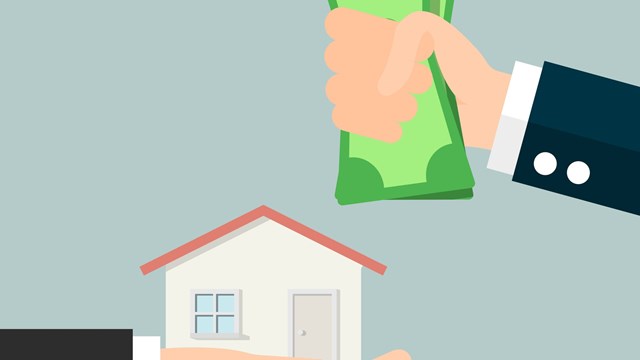There's no doubt about it: New York is the place to be once again, buyers just can't get enough of it. In fact, the biggest problem in residential real estate these days is that there just isn't any available.
"You can't find a good apartment for a million bucks anymore," laments Gregory A. Roach, president of GAR Associates, a design and construction planning firm in Manhattan. While for most people, finding the million bucks is the big challenge, for Roach's clients, a couple moving to the Big Apple from the Southwest, the challenge is spending it.
"Many of the brokers I called had no product at all that met their criteria," Roach explains. "And the apartments they did show me were covered with a quick coat of paint and had only the most basic architectural detailing." After visiting dozens of co-ops and condos, searching for the ideal three-bedroom on a high floor with over 2,000 square feet and plenty of open spaces, "We've given up on the existing market," Roach concedes. "Now we're hoping to buy in one of the new luxury developments currently under construction. It may take a year or 18 months before they can move in, but at least my clients will have what they want."
Roach's clients are not unique in their strategy to buy what has not yet been built. In a return to a trend that was very big in the late 1980s, pre-construction sales are extremely strong. Adrienne Albert, president of The Marketing Directors, a real estate marketing firm based in Manhattan, reports that in the last three weeks, nearly ten percent of the 377 apartments at 200 Riverside Boulevard, the first condo to come on line at Trump's new Riverside South development, were sold.
"Even the new developments coming on line are a drop in the bucket compared with the demand," says Albert, pointing out that there is not much that will be completed in 1999. "Buyers have no choice but to wait," she says, adding that people have come to expect very little risk when it comes to pre-construction buying. Often they are spending hundreds of thousands - even millions - of dollars based only on floor plans. Some buildings are far enough along to feature model apartments, and others build actual kitchens and bathrooms at their sales offices to give buyers an authentic taste of what's to come.
Although over 30 new properties are at various stages of planning and construction, only 16 will actually become available in Manhattan in 1999, and several of those are small downtown loft buildings. Among those uptown buildings coming on-line in 1999, Zeckendorf Realty's 515 Park Avenue is reportedly nearly sold out - and commanding prices in excess of $1,000 per square foot! Prices in the building range from $2.5 million to $12 million.
The former Westbury Hotel, at 15 East 69th Street, has been converted to 47 condominiums with two to five bedrooms each. Prices range from $1.4 million to $6 million. And Macklowe Development's 145 East 76th Street features 22 units ranging from $2 million to $7 million. So what are you waiting for? Better sign up now before they're all gone, because they are all selling "like hotcakes," say real estate professionals.
The lament is echoed throughout the canyons of Manhattan: there are no good apartments left. Even the studios and one-bedrooms, which were glutting the market just two years ago, have been fully absorbed. In fact, according to a study compiled for the brokerage firm Douglas Elliman by Miller Samuel, Inc., a Manhattan residential real estate appraisal and consulting company, studios represented over 20 percent of all the co-ops sold in Manhattan in the fourth quarter of 1998. The Real Estate Board of New York (REBNY) reports in their fourth quarter Cooperative Sales Report that studio and one-bedroom apartments accounted for 54 percent of total co-op sales.
The lack of product has sent prices skyward. According to the Marketing Directors' report, the average sales price for condominium studios was $207,676, up 23.7 percent over 1997. In two-bedrooms, they show an average of $580,696, up 14.2 percent, and in three-bedrooms, where the supply of apartments is smaller than ever, the average sales price was $1.24 million, more than 50 percent over 1997!
Year-end figures reported by the Halstead Property Company, a brokerage firm with several Manhattan offices, show an average price of $159,000 for all residential properties below 96th Street, an increase of 16 percent over the previous year. In the super luxury market, the average was $323,000, up 13.5 percent from 1997.
According to The Corcoran Report, the year-end statistics compiled by The Corcoran Group, a Manhattan real estate brokerage firm, the average apartment sales price was $515,000, up 11 percent from 1997. Corcoran reports that selling prices for four-bedroom units and larger increased by 38 percent on the Upper East Side and 34 percent on the Upper West Side. They also report that price negotiability dropped to 6.6 percent.
Even though today's prices have matched and exceeded the heady highs of the 1980s, many real estate professionals see the '90s as altogether different.
"I see no parallel to the peak of the '80s," says Barbara Corcoran, chairman of The Corcoran Group. "It feels more like the '70s; like there's a fire sale in town." She explains: "In 1987, people were reluctant to reach up to the prices being asked. Now it's like the California gold rush - people want to spend and are willing to play. In the '80s, the people in finance were the best buyers. Today, it's everybody!"
Corcoran points out that prices are only five to ten percent higher today than they were in the '80s - not much inflation when it comes to such a valuable commodity; just look at Internet stocks! In the '80s, however, prices were ten times higher than in the '70s, so people have had ten years to get used to the prices of today. And, as Adrienne Albert points out, when it comes to world class cities, New York is still a bargain.
Peter Marra, president of William B. May, a brokerage firm based in Manhattan, sees quite a few parallels between today's market and that of the late 1980s. But one big difference, he says, is that "There was a lot of new product coming on the market in the '80s. Today there is some new property, but it's very expensive, and it's sold before it's even built." He adds that in the '80s buyers were very specific about location, whereas today they are more likely to take whatever they can find.
"There's not a lot of building going on like there was in the '80s when the market was glutted with new properties," agrees Barbara Fox, president of the Fox Residential Group, a Manhattan brokerage firm. "Prices are at an all-time high and demand is driving them even higher," she adds. Fox also believes that the new capital gains law, which removed the incentive to sellers who buy within 18 months, has led some people to hold onto "old family apartments" instead of taking their profits and buying something smaller and less expensive. Without the reinvestment provision, sellers would face a large tax liability by selling at a large profit and would have trouble finding something comparable to replace the property with.
According to Marra, the high prices and lack of product in Manhattan are also driving markets in the outer boroughs. "Sixty percent of the Park Slope buyers are coming from Manhattan," he says. "They are moving for the space or because they couldn't afford Manhattan - and these buyers have money; they're buying townhouses."
Adrienne Albert seconds that opinion, saying, "Outside of Manhattan, very few places are not doing well now. New Jersey's Hudson River coast is booming. And with the Path and the ferries, commuting is easy now. People are moving there for more space at less cost." She cites Jersey City, Hoboken and Edgewater as booming areas across the river, adding that Long Island is also doing very well. "I can't think of any section of the market that isn't doing well right now," she concedes. Except for the "blip" in the stock market last August that caused real estate sales to slow down for a couple of months, 1998 was a "banner year" for co-op and condo sales. And experts agree that 1999 will probably be even better. With demand far outpacing supply, buyers are facing a tough market these days. In fact, Barbara Corcoran observes that "People want to sell but are waiting to get more money for their apartments. They're holding tight because they know they can get more tomorrow."






Leave a Comment